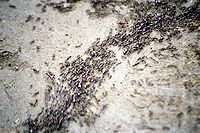
Photo from wikipedia
Abstract Optimal design of (highly) conductive pathways embedded in a heat-generating piece is becoming a continuing challenge since the rapid progress in miniaturization of heat-generating pieces such as electronic chips.… Click to show full abstract
Abstract Optimal design of (highly) conductive pathways embedded in a heat-generating piece is becoming a continuing challenge since the rapid progress in miniaturization of heat-generating pieces such as electronic chips. The objective of optimization is to maximize the thermal performance under the constraint of fixed amount of highly conductive materials. Unlike the optimal designs that are proposed in literature based on a pre-assumed shape (such as I-shaped, H-shaped, X-shaped or V-shaped configurations) or a time-consuming algorithm (such as Genetic Algorithm), a new fast algorithm is proposed to deliver a near-optimum thermal design that minimizes the hot spot temperature. The new algorithm is based on the recursive localization of rectangular pieces of highly conductive materials, touching previously localized ones. The optimization results are compared with those reached in the open literature to indicate that the proposed algorithm is promising, efficient and fast. It was also indicated that morphing the insert aspect ratio could enhance the effectiveness of the proposed algorithm.
Journal Title: Applied Thermal Engineering
Year Published: 2019
Link to full text (if available)
Share on Social Media: Sign Up to like & get
recommendations!